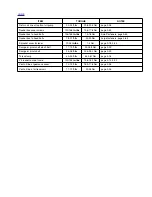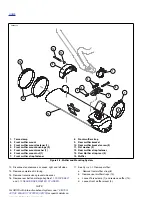
3-6
2004 Buell Lightning: Engine
HOME
ENGINE
3.2
FUEL
Gasoline/alcohol Blends
Buell Lightning motorcycles have been designed to obtain the
best performance and efficiency using a good quality
unleaded gasoline. Buell recommends using at least 91 pump
octane (RON). Octane rating is usually found on the pump.
Some fuel suppliers sell gasoline/alcohol blends as a fuel.
The type and amount of alcohol added to the fuel is impor-
tant.
●
DO NOT USE GASOLINES CONTAINING METHANOL.
Using gasoline/methanol blends will result in starting and
driveability deterioration and damage to critical fuel sys-
tem components.
●
Gasolines containing ETHANOL: Gasoline/ethanol
blends are mixture of 10% ethanol (Grain alcohol) and
90% unleaded gasoline. Gasoline/ethanol blends can be
used in your motorcycle if the ethanol content does not
exceed 10%.
●
Gasolines containing ETHER: Gasoline/ether blends are
a mixture of gasoline and as much as 15% ether. Gaso-
line/ether blends can be used in your motorcycle if the
ether content does not exceed 17%.
●
REFORMULATED OR OXYGENATED GASOLINES
(RFG): “Reformulated gasoline” is a term used to
describe gasoline blends that are specifically designed to
burn cleaner than other types of gasoline, leaving fewer
“tailpipe” emissions. They are also formulated to evapo-
rate less when you are filling your tank. Reformulated
gasolines use additives to “oxygenate” the gas. Your
motorcycle will run normally using this type of gas. Buell
recommends you use it when possible, as an aid to
cleaner air in our environment.
Because of their generally higher volatility, these blends may
adversely affect the starting, driveability and fuel efficiency of
your motorcycle. If you experience these problems, Buell rec-
ommends that you operate your motorcycle on straight,
unleaded gasoline.
LUBRICATION
The engine has a force-feed (pressure) type oiling system,
incorporating oil feed and return pumps in one pump body,
with one check valve on the oil feed side. The feed pump
forces oil through the oil cooler to the engine, lubricating
lower connecting rod bearings, rocker arm bushings, valve
stems, valve springs, push rods and tappets. Cylinder wall,
piston, piston pin, timing gears, bushings and main bearings
are lubricated by oil spray thrown off connecting rods and
crankshaft, and by oil draining from each rocker box through
an internal drain passage in each cylinder and each tappet
guide. Oil is transferred to the teeth of all the cam gears by
way of the gear meshing action. The oil-scavenging section of
the pump returns oil to the tank from the engine. See
3.8
LUBRICATION SYSTEM
for more information.
ADJUSTMENT/TESTING
General
When an engine needs repair, it is not always possible to
determine definitely beforehand whether repair is possible
with only cylinder head, cylinder and piston disassembled or
whether complete engine disassembly is required for crank-
case repair.
Most commonly, only cylinder head and cylinder repair is
needed (valves, rings, piston, etc.) and it is recommended
procedure to service these units first, allowing engine crank-
case to remain in frame.
See
3.4 STRIPPING MOTORCYCLE FOR ENGINE SER-
VICE
to strip motorcycle for removal of cylinder head, cylin-
der, and piston.
After disassembling “upper end” only, it may be found that
crankcase repair is necessary. In this situation, remove the
engine crankcase from the chassis.
CAUTION
If engine is removed from chassis, do not lay engine on
primary side. Placing engine on primary side will damage
clutch cable end fitting. If fitting is damaged, clutch cable
must be replaced.
See
1.22 TROUBLESHOOTING
section. Symptoms indicat-
ing a need for engine repair are often misleading, but gener-
ally, if more than one symptom is present, possible causes
can be narrowed down to make at least a partial diagnosis.
An above-normal consumption of oil, for example, could be
caused by several mechanical faults. However, when accom-
panied by blue-gray exhaust smoke and low engine compres-
sion, it indicates the piston rings need replacing. Low
compression by itself, however, may indicate improperly
seated valves, in addition to or in lieu of worn piston rings.
Most frequently, valves, rings, pins, bushings, and bearings
need attention at about the same time. If the possible causes
can be narrowed down through the process of elimination to
indicate any one of the above components is worn, it is best
to give attention to all of the cylinder head and cylinder parts.
Содержание 2004 XB9S
Страница 2: ......
Страница 35: ...D 2 2004 Buell Lightning Appendix D HOME Rear Brake Systems Top View b1115xbsx ...
Страница 36: ...2004 Buell Lightning Appendix D D 3 HOME Rear Brake Systems Left Side View b1116xcsx ...
Страница 44: ...2004 Buell Lightning Appendix D D 11 HOME Clutch Cable Right Side View b1124xasx ...
Страница 47: ...HOME NOTES ...
Страница 49: ......
Страница 103: ......
Страница 201: ...HOME NOTES ...
Страница 203: ......
Страница 275: ...HOME NOTES ...
Страница 307: ...HOME NOTES ...
Страница 311: ...HOME NOTES ...
Страница 351: ...HOME NOTES ...
Страница 441: ......
Страница 463: ...HOME NOTES ...
Страница 465: ......
Страница 511: ...HOME Figure 6 83 Crankcase Fasteners D b1016x3x Indicates Bolt Pattern Location One Behind Shifter Mechanism ...
Страница 517: ...HOME NOTES ...
Страница 519: ......
Страница 563: ...HOME Figure 7 48 Headlight Housing 20º Alignment Marks for Rubber Boot Wiring Harness Guides or Spigots 10525 10526 ...
Страница 595: ...HOME NOTES ...
Страница 597: ......
















































